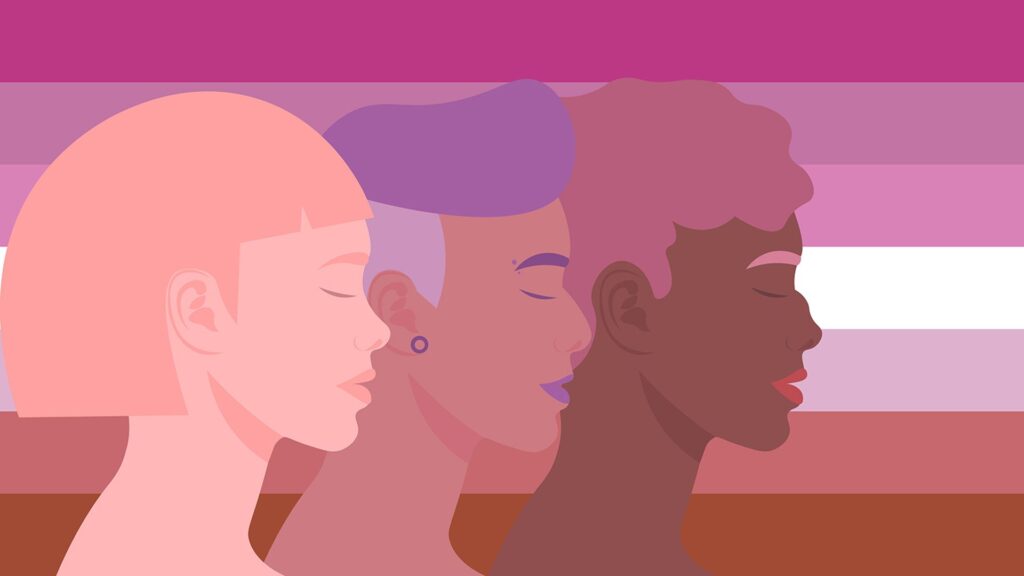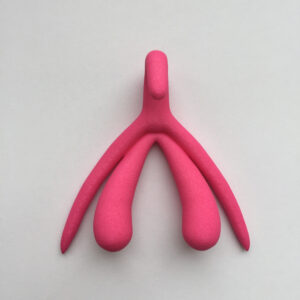Lesbian Visibility Day

Am I allowed to use the word clitoris in a work environment?
If I can say kidney, I can say clitoris. Compared to the kidney, which is five inches long, the major female organ, called the clitoris, is 9-11 inches long – and continues to grow through life. Did you know it could be two and a half times bigger in your 90s than in your teens? I bet you didn’t! Most of us know hardly anything about this organ at all. It was even removed from the “Dr’s Bible”, Gray’s Anatomy, in 1947! Yes, an organ was erased from a medical textbook!
Why? And what does that have to do with Lesbian Visibility Day?
If you are asking that question, then you are definitely not a Lesbian. So here, I’m making this visible by talking about it, and how women and their organs were, and still are considered to “threaten the Patriarchy”. And how Lesbians are understood to have defied this and consequently become an even bigger threat. Thus experienced, and still experience, further marginalisation.
I would like to note here that not everyone who identifies as a woman and/or a Lesbian has a clitoris, and not everyone who has a clitoris identifies as a woman. What has been made so plainly clear to me in researching for this post is that our research studies and historical texts are significantly biased towards cisgender identities. I write this blog with this inequity firmly in mind and with a passion for us to do better at including minorities within minorities in future research.
With this in mind, I’m going to start with a very brief history…
The clitoris throughout history has had various names. It was referred to in medical or scientific text as ‘Devil’s treat’ (1486). ‘Shameful member’ (1545). ‘Seat of Venus’ (1559).
Lesbianism was never illegal. The UK partially decriminalised same-sex relations between men in 1967, but that didn’t apply to women, as same-sex relations between women were not illegal. In fact, whilst there were cases in the 1800s where women were prosecuted for having sex with other women, they were kept very quiet. The reason for that is that men didn’t want “respectable” women – their wives or daughters – to find out such “indecency” existed (which would have upset the Patriarchy!).
In the early 1900s, Freud described the clitoris as infantile, and a mature, feminine woman ultimately has to switch to only having orgasms through vaginal intercourse or “risk psychological disorder” (Freud considered Lesbianism as one of these psychological disorders, despite his own daughter identifying as a Lesbian.) If a woman is unable to have an orgasm like that, they are “frigid”.
Throughout the 1900s, Feminism was often associated with Lesbianism. Lesbians, as well as Feminists, were called “man-haters”, and other derogatory terms. Straight women risked being perceived as Lesbians if they wanted to join the Feminist movement. Homosexuality was classified by the World Health Organisation as a mental disorder until 1990.
Are you starting to see the connection now?
You might say, “But all of this stuff is in the past…”. Is it?
In 2005, a study described that “in light of gender inequality and a social construction of sexuality, endorsed by both men and women, that privileges men’s sexual pleasure over women’s, such that orgasm for women is pleasing, but ultimately incidental”.
It was also in 2005 when the anatomy of the clitoris was finally mapped by Helen O’Connell. We have known the shape of the clitoris for less than 20 years. By contrast, the optic nerve and its relationship to the eye were described by anatomists in the 12th century.
In 2016, the term “the orgasm gap” was used in a study, which observed that 95% of heterosexual men have an orgasm “usually or always” vs 65% of heterosexual women. This number goes up to 86% for Lesbian women.

It was in a study in 2017 that researchers confirmed the absence of an anatomic “G-spot”, as previously believed. “G-spot” is now known to be part of the clitoris network.
In a study in 2022 at the University of Manchester, less than 10% of participants labelled all female external genitalia on a diagram correctly. Interestingly for this study, the participants were asked to identify their age, race, education, etc, but not their sexual orientation.
Interesting history, isn’t it?
But for me, the most shocking fact of all that stood out throughout history is that women have an organ that is for pleasure only. So, what is stopping us from making the most of that? The hundreds of years of dominance and privilege held by men, The Patriarchy.
Can you see, how throughout history, Patriarchy has been keeping female pleasure at bay? And how Lesbians have interrupted that and therefore caused a threat? Therefore, they need to further marginalise them as a group?
Another interesting part of this narrative is that when Lesbians started to be socially more accepted, the narrative quickly changed to please the “male gaze”. From the 1990s, media representation of woman-woman relationships and representation was designed to please men. In many TV programmes or films, two women kissing were actually portraying heterosexual characters kissing to try to be more attractive for men in the show, or men in the audience. Gilmore Girls and Friends are just a couple of examples of this.
But it’s not just men. The Patriarchy has influenced the way heterosexual women think of Lesbians, just like the 2005 study quoted above found.
I don’t have a study to prove this, but I have however the lived experience, as well as the lived experience of peers to showcase this: Straight women have used Lesbians to try to attract men. Many of us have seen this, especially on a drunken night out. Straight women “use” or “lead on” Lesbian women to make themselves feel better. Straight women think Lesbians flirt with them when looking at their new haircut or outfit. Or even if looked at for an extra second too long…
Lesbians have to be very careful. Lesbians are constantly profiled. Lesbians are stereotyped.
Well, surprise! Lesbians are not all butch. Lesbians don’t fancy all women. Lesbians don’t hate men. And not all Lesbians have clitorises.
Anyhow, based on research, on stats and on lived experience, this is where we are now. But Lesbians do know a bit about the clitoris. And now you do too.
Bonnie Erdelyi-Betts
HR Project Manager and Projects Lead for the LGBT+ Staff Network
Equity, Diversity and Inclusion
Reflections, comments, discussion and opinion on EDI topics from Loughborough University staff and students